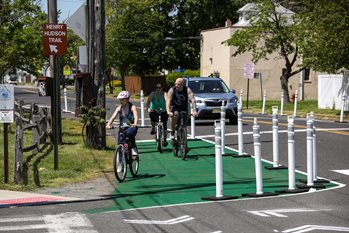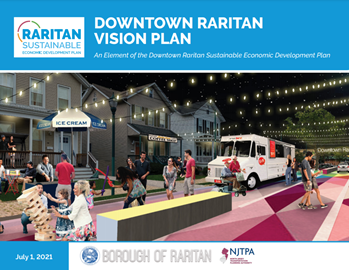August 2021
Posted: 8/31/2021 9:00:00 AM

The Henry Hudson Trail cuts across the intersection of Maple Place at Church and Atlantic streets in Keyport, sometimes creating challenging navigation for pedestrians, cyclists and vehicles. But with the help of some temporary paint and plastic bollards, the Borough was able to demonstrate what potential improvements, including a bicycle lane, designated pedestrian space and additional crosswalk, could do to make the area safer for all travelers.
The week-long temporary demonstration project was one component of extensive public outreach for Keyport’s Complete Streets Policy and Implementation Plan. The plan was recently completed though the NJTPA’s Planning for Emerging Centers Program. The competitive program provides technical assistance to communities to create more sustainable, transit-supportive and walkable communities.
Complete streets are roads designed for users of all ability levels and all travel modes. They balance the needs of pedestrians, bicyclists, drivers, transit riders, emergency responders and goods movement. Several documents were created as part of the study, including an ordinance that would add complete streets implementation to Keyport's municipal code, as well as design and implementation guides. The Complete Streets Design Guide identifies priority locations and recommends improvements. It also identifies priority pedestrian and bicycle networks and areas to incorporate green stormwater management, which could help mitigate flooding.
The Implementation Guide supports the complete streets ordinance and design guide. It presents best practices for implementing complete streets projects and encourages community involvement. The guide provides criteria for prioritizing projects and identifies potential funding sources.
In addition, a Quick Build Guide was developed to assist Keyport in identifying additional opportunities for temporary demonstration projects, which could help the Borough build community support and test out potential improvements before making more permanent changes. Visit the Keyport Complete Streets Policy and Implementation Plan webpage to learn more about the study and view the documents.
Posted: 8/27/2021 2:56:40 PM
 The Borough of Raritan recently completed a year-long community-driven study that aims to increase the economic vitality of its downtown and better connect Somerset Street to the train station and riverfront.
The Borough of Raritan recently completed a year-long community-driven study that aims to increase the economic vitality of its downtown and better connect Somerset Street to the train station and riverfront.
This Sustainable Economic Development Plan that was created through the NJTPA’s Planning for Emerging Centers Program. The competitive program provides technical assistance to communities to create more sustainable, transit-supportive and walkable communities.
The recently completed Raritan studyused extensive community outreach to develop a 10-year vision for the downtown’s future. In addition to the plan, the effort also suggested a regulatory framework to make the vision a reality and an implementation toolbox to provide Raritan with specific recommendations it can act on.
Residents who participated in outreach activities said they wanted an active and attractive downtown that better connects Somerset Street to a vibrant riverfront destination. They envisioned the riverfront area with a completed Raritan River Greenway and high-quality recreation spaces. Pedestrian and bicycle safety were top concerns and there was also a desire to provide more travel options.
The plan recommends revitalizing underutilized spaces and adding amenities, such as landscaping, public art and outdoor dining. It suggested mixed-use developments that could support existing restaurants or accommodate new ones and modern retail spaces at ground level with housing above. The Vision Plan also suggests installing bike lanes to connect the riverfront to the downtown and residential neighborhoods.
The borough created a working group to guide the study, and the implementation guide calls for continuing that group to keep the various stakeholders — local and county officials, residents, businesses and others — engaged in making the plan a reality. While the Implementation Toolkit was developed with Raritan in mind, other municipalities facing similar challenges could benefit from some of its recommended strategies.
For additional information visit the Raritan Sustainable Economic Development Plan page to view the Vision Plan and Implementation Toolkit.
Posted: 8/23/2021 11:14:53 AM
The Transportation Research Board announced today that it has awarded the 2022 Thomas B. Deen Distinguished Lectureship to Anne Strauss-Wieder, Director of Freight Planning at the NJTPA.
Ms. Strauss-Wieder has more than 40 years of public and private sector experience involving supply chains, industrial and economic development, resilience, and multi-modal freight movement. As Director of Freight Planning, she works to address key regional freight issues and trends, collaborates with private sector organizations and works closely with partner agencies to advance freight initiatives.
The lectureship recognizes the career contributions and achievements of an individual in one of the areas covered by TRB’s Technical Activities Division. Originally known as the Transportation Research Board Distinguished Lectureship, the award was renamed in 2002 in honor of the eighth TRB Executive Director, who served with distinction from 1980 to 1994. Honorees are invited to present overviews of their technical areas including evolution, present status, and prospects for the future. TRB also publishes each lecture in a volume of the Transportation Research Record: Journal of the Transportation Research Board.
Ms. Strauss-Wieder will delivered her lecture, “Evolving with Rapidly Shifting Supply Chains and Freight Systems: The Past, the Present, and the Emerging Future,” on Monday, January 10, 2022, as part of TRB’s 2022 Annual Meeting.
For more information visit www.trb.org.
Posted: 8/18/2021 4:27:58 PM
The NJTPA Board of Trustees will consider three key documents for final adoption at its September meeting — the Long Range Transportation Plan, Transportation Improvement Program and Air Quality Conformity Determination.
The Board’s Planning and Economic Development Committee approved the draft long-range plan, Plan 2050: Transportation, People, Opportunity, at the joint committee meeting Monday. At the same meeting, the Project Prioritization Committee approved the draft FY 2022-2025 Transportation Improvement Program and accompanying Air Quality Conformity Determination.
The documents will be on the agenda for the Board’s September 13 meeting.
All three documents – along with the State Transportation Improvement Program – underwent a formal public comment period from July 6 to August 4, including a well-attended public meeting. More than 100 individuals and organizations commented on the documents at the meeting or through submissions. Summaries of the public comments and NJTPA’s responses are posted on the Plan 2050 webpage along with the full text comments.
Plan 2050 was developed with extensive public engagement. More than 2,000 people provided input during its development through surveys, phone calls, virtual public events and focus groups aimed at engaging underserved populations. Plan 2050 looks toward an economic recovery over the next five to 10 years. By 2050, the region’s population is projected to grow by 15 percent to 7.7 million, vehicle miles of travel will grow by 11 percent and freight movement will grow by 16 percent. Among the priorities in the plan:
- Safety — Reducing crashes and ensuring the safety of all travelers must continue to be a primary focus across all policies, programs and investment.
- Accessibility — The region’s planning must continue to shift its focus away from moving vehicles to one of accessibility – that is, using a variety of modes to give people convenient and affordable access to jobs, education and other opportunities.
- Equity —The transportation system must more fully address the needs of low-income and minority communities, which have been traditionally underserved.
- Roads & Bridges — Fix it first is the priority to reduce the backlog of needed road and bridge improvements and upgrade facilities while also preparing infrastructure for climate change impacts.
- Transit — Improving transit is a key to solving some of the most difficult challenges but increased funding and more stable funding mechanisms are needed. The Hudson River tunnel project and the larger Gateway project are NJTPA’s top transit investment priorities.
- Active Transportation — Improve connectivity between neighborhoods and key destinations, especially in places with schools, high transit use and lower incomes.
- Climate Change — Support climate change policies and initiatives of the State of New Jersey – captured in the NJDEP’s October 2020 Global Warming Response Act 80x50 Report
- Transportation Technologies — Support transportation technology applications and guide the region in their use.
- Freight — Address existing freight infrastructure needs and prepare for growth in overall freight volume by 2050 as well as the challenges of e-commerce.
- Environment – A separate Environment chapter highlights the importance of efforts in the areas of air quality, climate change and environmental mitigation.
- Financial Element – The plan offers a fiscally constrained financial plan based on realistic projects along with scenarios addressing more limited or additional funding.